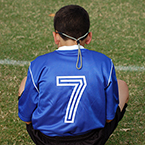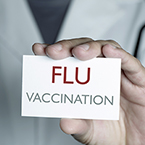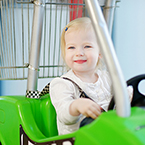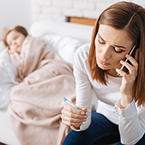Fall 2019
The Problems With Perfection
 As parents, it’s tempting to push our kids to do better, and it may even feel like it’s our job to do so. We might push them to have neater coloring skills, to be early readers, to earn the ‘first chair’ in band, to make a select sports team, to earn top grades — and the list goes on.
As parents, it’s tempting to push our kids to do better, and it may even feel like it’s our job to do so. We might push them to have neater coloring skills, to be early readers, to earn the ‘first chair’ in band, to make a select sports team, to earn top grades — and the list goes on.
However, when kids feel too much pressure to achieve — when they feel they must be perfect rather than simply try their best — this is perfectionism. It’s setting the bar too high for our achievements and behaviors, then thinking and feeling negatively when we can’t meet those expectations. It’s no wonder that perfectionism, which is a symptom of anxiety, can lead to serious health risks including depression and eating disorders.
Perfectionism shows up in various ways. Expecting ourselves to be perfect can cause tension, worry and other problems. Expecting others to be perfect makes it hard to have healthy relationships; others don’t enjoy being with us if we’re always unhappy with how they do things and we’re always demanding more from them. Finally, if we believe that others expect us to be perfect, we worry that our friends and family will approve of us only if we do what they want us to do, and act the way they want us to act.
So, how can parents help kids avoid the traps of perfectionism? We can praise their efforts rather than the results. We can help them set realistic expectations. We can encourage them to try new things — and to focus on the fun of the experience rather than on their skill level. We can be sure they have plenty of free play time, which may mean limiting after-school activities and other structured events like lessons, clubs and sports teams.
To be clear, wanting to be good at things is great! However, getting things done is better than getting things perfect. Overthinking and putting things off can become stubborn habits that paralyze us and make us miserable. Instead, we can accept our imperfections. We can even share our ‘best mistakes of the day’ at the family dinner table, find the humor in our missteps, and celebrate what we’ve learned. After all, aren’t we lucky to be imperfect human beings with loving hearts, rather than perfect, boring robots?
Visit our Psychiatry and Behavioral Medicine resources to learn more.
Giving the Gift of Safety
 Will your child be getting a new bicycle this holiday season? If so, consider purchasing a bike helmet that meets U.S. Consumer Product Safety Commission (CPSC) or Snell standards.
Will your child be getting a new bicycle this holiday season? If so, consider purchasing a bike helmet that meets U.S. Consumer Product Safety Commission (CPSC) or Snell standards.
Will you be heading somewhere warm for the holidays or for an upcoming school break? If you’ll be in or on the water, purchase a new U.S. Coast Guard-approved life jacket for your child.
It’s best to buy new safety gear, rather than purchasing used or receiving hand-me-down gear. That way you know the history of the gear, and that it’s in good condition.
Other health-and-safety-related gift ideas include shin guards, wrist guards, knee and elbow pads, ski goggles and water bottles.
Read Safety Gear for Sports and Play to learn more.
No More Playing Through Pain
 The days of parents telling their children with sports injuries to “push through it” are over. Doctors and athletic trainers now warn parents and coaches that the consequences of allowing children to play through sports injuries are not worth the risk.
The days of parents telling their children with sports injuries to “push through it” are over. Doctors and athletic trainers now warn parents and coaches that the consequences of allowing children to play through sports injuries are not worth the risk.
Playing through an injury can worsen the existing injury, cause damage to another area of their body, or even end their sports careers completely. A small injury that could have healed quickly can worsen and take longer to heal.
Children may try to hide their pain by compensating for their injury through limping, using their other hand for throwing a ball, or altering their natural techniques. Compensation may help prevent further damage to the injured area, but puts other areas at risk of injury.
Pushing children to continue playing a sport when injured can also cause emotional stress. The emotional and physical burdens from playing through an injury can contribute to burnout.
Play it safe — have your child sit out when injured and see their doctor for care.
Get tips for preventing sports injuries.
Growing Up Triggers Changes in Checkups
 Starting when kids are tweens, during their medical checkups it’s usual for parents to be asked to leave the room for part of the visit. This is done so the doctor (or the primary health care provider) and the child can speak in private. Parents may feel surprised or puzzled the first time this happens. But in fact, starting somewhere around age 11, a key part of your child’s overall good health is being able to have one-on-one conversations with their doctor.
Starting when kids are tweens, during their medical checkups it’s usual for parents to be asked to leave the room for part of the visit. This is done so the doctor (or the primary health care provider) and the child can speak in private. Parents may feel surprised or puzzled the first time this happens. But in fact, starting somewhere around age 11, a key part of your child’s overall good health is being able to have one-on-one conversations with their doctor.
Since adolescence is a period of such big change both physically and emotionally, a doctor’s job is to monitor their young patients’ overall physical and emotional health. This is why doctors are trained to weave in certain questions during the checkup relating to home, school and education, activities and social life, drug use or experimentation, sexuality, and safety. Where they detect any concerns, they can then provide education on those topics. (They will also explain doctor-patient confidentiality and its limits. Read Teens and Privacy Rights to learn more.) Most kids are more apt to answer their doctor honestly and ask their own questions when a parent is not present.
Parents can encourage kids to take ownership of their own health and wellbeing, and to speak openly with their doctor. Suggest jotting down any questions they’d like to ask before their visit to be sure they cover the topic. Reassure them that doctors hear all sorts of questions, and they won’t be shocked or surprised by anything. Regular checkups remain crucial as kids get older. Your child should have one medical checkup and two dental checkups each year through the tween, teen and young-adult years.
2019–2020 Flu Vaccine
 A flu vaccine is the best way to prevent getting sick with the flu (influenza). One change for the 2019–2020 flu season is that the nasal spray flu vaccine is back as an option for healthy people ages 2 through 49. You may recall that in the past few years, the nasal spray delivery method was not recommended due to concerns about how well it worked. But the formula has been updated, and the latest data shows the new nasal spray to be effective. The flu can be very serious, and people die from the disease each year. So, whether you opt for the nasal spray vaccine or a traditional flu shot, be sure you and your family are protected. Talk with your child’s doctor if you have any questions.
A flu vaccine is the best way to prevent getting sick with the flu (influenza). One change for the 2019–2020 flu season is that the nasal spray flu vaccine is back as an option for healthy people ages 2 through 49. You may recall that in the past few years, the nasal spray delivery method was not recommended due to concerns about how well it worked. But the formula has been updated, and the latest data shows the new nasal spray to be effective. The flu can be very serious, and people die from the disease each year. So, whether you opt for the nasal spray vaccine or a traditional flu shot, be sure you and your family are protected. Talk with your child’s doctor if you have any questions.
Shopping Cart Safety
 Each year, thousands of children — most ages 0 to 4 — get hurt from riding in shopping carts. To prevent falls and other injuries, avoid having a child ride in the cart. Instead, carry infants close to your chest in a front carrier if possible; never put an infant carrier on top of the cart. For toddlers, carts with attached child seats low to the ground (as pictured) are safer than riding in the cart’s seat. If you must use the cart’s seat, be sure your child is buckled in snugly with each leg hanging through its own leg opening. Then, ensure they remain seated and buckled at all times. Bigger kids are safest walking close beside you.
Each year, thousands of children — most ages 0 to 4 — get hurt from riding in shopping carts. To prevent falls and other injuries, avoid having a child ride in the cart. Instead, carry infants close to your chest in a front carrier if possible; never put an infant carrier on top of the cart. For toddlers, carts with attached child seats low to the ground (as pictured) are safer than riding in the cart’s seat. If you must use the cart’s seat, be sure your child is buckled in snugly with each leg hanging through its own leg opening. Then, ensure they remain seated and buckled at all times. Bigger kids are safest walking close beside you.
Get more fall prevention tips.
Measles
 Measles is highly contagious. In fact, the Centers for Disease Control reports that “It is so contagious that if one person has it, up to 90% of the people around him or her will also become infected if they are not protected.” Recent outbreaks of this serious disease show this to be true. The good news is that measles is preventable thanks to the MMR (measles, mumps, and rubella) vaccine.
Measles is highly contagious. In fact, the Centers for Disease Control reports that “It is so contagious that if one person has it, up to 90% of the people around him or her will also become infected if they are not protected.” Recent outbreaks of this serious disease show this to be true. The good news is that measles is preventable thanks to the MMR (measles, mumps, and rubella) vaccine.
If you suspect your child or another family member has the measles, call your health care provider before seeking care, so you don’t spread the disease. Measles symptoms typically include high fever, cough, runny nose and watery eyes, with a measles rash appearing 3 to 5 days after the first symptoms.
Learn more about measles.
Quick Tip
A consistent bedtime routine helps toddlers form good sleep habits. Wind down with a book, bath or calm music at the same time each night.